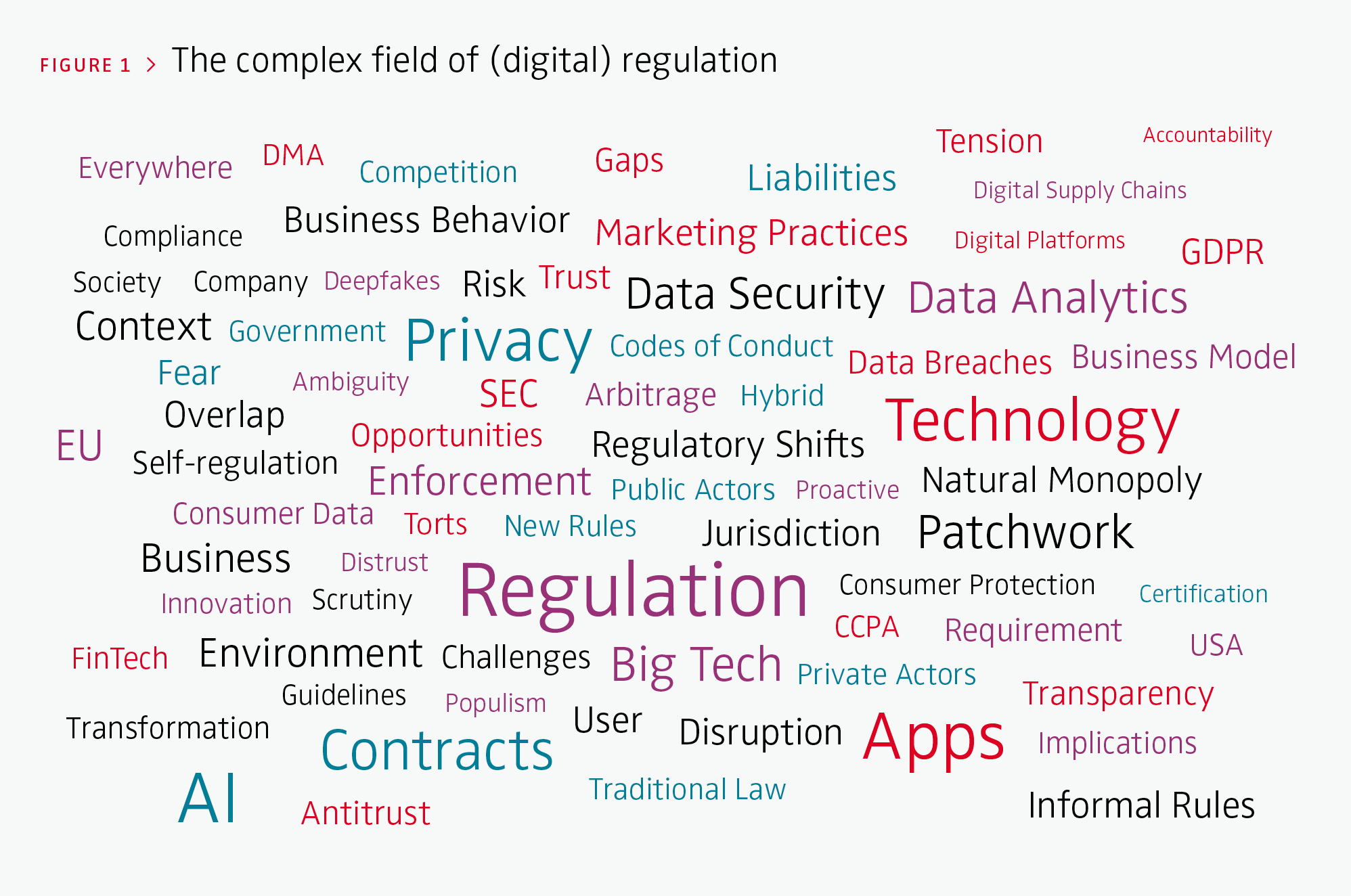 Download
Download
Mastering the Digital Regulatory Maze: Strategies for Marketing Success in a Complex Landscape
Regulation everywhere
In today’s world, the issue with regulation is that it is everywhere. It takes on many facets, such as privacy and data breaches of consumer data, and covers antitrust/competition, AI and fintech. Examples that affect privacy are the General Data Protection Regulation (GDPR) in the EU or the California Consumer Privacy Act (CCPA), and competition regulation can be found in the EU Digital Markets Act (DMA). The many new rules and regulations are shaping business behavior and transforming how businesses operate. Regulatory shifts have profound implications for marketers, including marketing practices such as tying, bundling and exclusive dealing. They further affect basic contractual mechanisms that encourage discoverability of new customers and create platform ecosystems. Figure 1 shows the complexity of this field in a randomly arranged word cloud.
Different levels of regulation
Marketers need to understand different forms of regulation. For example, there is traditional government regulation when there is a natural monopoly. This could be something like telecommunications or an electric utility. But then there is also regulation between public and private actors that we see all the time in traditional marketing areas, such as codes of conduct like in supermarkets in the United Kingdom or Australia. Finally, there is purely private regulation in which the enforcement mechanism is through contracts, such as across each platform ecosystem (between the platform and its users), or through certification through third parties of digital supply chains. Digital supply chains increasingly play an important role in data analytics, discovery of new consumers and targeted advertising. Either government regulation or hybrid regulation are now increasingly common where once the focus was on private contracting. Indeed, some governments view digital platforms as a new kind of natural monopoly
Regulation is patchwork: overlaps, blank spaces and tension
Some rules are specific to the digital economy and have been put into place specifically to address real and perceived issues that the digital economy creates. Examples are the above-mentioned GDPR, CCPA, DMA or data security rules released by the US Securities and Exchange Commission (SEC). Further, there are unique interactions of more generally applicable legal rules in the digital context, such as contracts, torts and antitrust regulation. Finally, there are informal norms, such as for reputation management, that may govern the organizational structure of the digital economy.
What is complicated is that these new digital rules create a global patchwork. In some cases, there are digital rules, and in others, there are only traditional rules. Occasionally, the rules overlap, and in other areas, there are gaps. In yet other cases, the overlap even exposes tensions across different legal regimes, jurisdictions and particular themes or industry sectors. But this is not the only challenge to marketers in the digital age from the standpoint of law and regulation.
Businesses need to respond fundamentally to the different legal and regulatory challenges.

Fear of technology is driving new regulation
In the past years, digital regulation has become even more significant. One of the justifications for more regulation is increasing fear of technology. AI has exacerbated this fear and the concern that certain services will be replaced. For instance, in marketing, there are concerns regarding deepfakes that take the form of people impersonating voices or scam consumers with regard to financial information. This creates distrust of the market. But the fear of technology has also been compounded by a decay of the political center across countries and the rise of populism that for various reasons pushes to limit the use of digital technologies. This is true of populist movements of both the left and the right.
How marketing can navigate the regulation maze successfully
There is both something new in digital regulation and something that is simply a repurposing of the existing rules. Digital regulation stems in part from legal and regulatory attempts in non-digital settings. All sorts of regulation and enforcement have already occurred in the non-digital setting for areas such as consumer protection, privacy and antitrust. Marketers have been well aware of these sorts of laws and regulations and have devised strategies to ensure compliance with laws while still pushing forward opportunities to expand markets. In this situation, the digital setting simply applies traditional marketing rules, but marketing needs to catch up to the new contexts and new rules. All of the discussed aspects shape the possibilities of digital marketing practices. The following guidelines should help marketers thrive in the new regulatory environment of digital platforms and businesses:
One of the justifications for more regulation is increasing fear of technology.
> Consider the effects of digital business on society and build trust
One broader lesson is that companies have made mistakes in ignoring the social costs of technology and have downplayed risks. Part of marketing strategy going forward is to understand the interaction between marketing practices with society at large and to build trust in digital marketing practices. Addressing trust issues means that businesses have to focus on increasing transparency and accountability of their various business practices in ways that at the same time do not hamper business innovation.
To a certain extent, businesses have not yet been effective in explaining the underlying technology that is often built on data and AI and the implications for business, law and society. Effective digital strategy means that entrepreneurs building out their platforms or their apps should account for potential regulatory scrutiny in the development and managing of their digital platforms. This means that companies need to understand the roles of platform contributors, users and the public overall.
> Respond fundamentally and be proactive
Businesses need to respond fundamentally to the different legal and regulatory challenges. This includes increased risk assessment of potential for liabilities for certain types of marketing practices as well as identifying regulatory gaps. There might be opportunities to exploit the lack of rules in ways that create value for both companies and their customers. Hence, businesses can focus on responding to regulation and laws in ways that are proactive. To improve digital strategy and manage risk, companies and marketers need to better understand how to feed their data analytics. They must ask what kinds of data get collected, who owns the data, who controls the data, what kinds of data can be mixed and what needs to be siloed.
> Consider self-regulation to avoid government regulation
Companies may want to self-regulate to foreclose more severe government regulation. This can be part of a larger digital regulatory strategy. Part of this strategy is to identify what the current requirements are as well as where there is ambiguity and opportunity for potential regulatory arbitrage that can expand markets or create new ones. This sort of strategy does not mean there is no risk. It is simply about managing risk effectively. Some of the most creative platform companies have been able to push in new directions and be ahead of regulation. Among the most impressive companies that have engaged regulators is Microsoft. Unlike some of its peer Big Tech companies, Microsoft has been able to stay under the radar for much digital regulation because of a very proactive strategy of engagement with government officials and explaining their business model.
Strategic regulatory engagement is part of a broader business strategy of differentiation. It is about competing based on moving to where current competitors are not. This is what is called a blue ocean strategy. Shifting to where your competition hasn’t yet arrived offers opportunities to expand into new markets and disrupt existing ones. It takes a while for regulation to catch up to such strategies. This creates some breathing room and opportunities to arbitrage existing laws and regulations to create value for companies and customers.
FURTHER READING
Cennamo, C., & Sokol, D. D. (2021). Can the EU regulate platforms without stifling innovation? Harvard Business Review. hbr.org/2021/03/ can-the-eu-regulate-platforms-without-stiflinginnovation
Rong, K., Sokol, D. D., Zhou, D., & Zhu, F. (2024). Antitrust platform regulation and entrepreneurship: Evidence from China. Harvard Business School Working Paper, No. 24-039. www.hbs.edu/faculty/ Pages/item.aspx?num=65262
Sokol, D. D., & Zhou, B. (2024). Antitrust regulation. Journal of Law and Innovation, 7. papers.ssrn. com/sol3/papers.cfm?abstract_id=4773345









